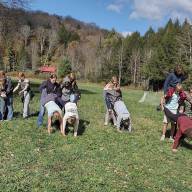Photo: Low flows near Hooper Lane reveal a narrow bedrock passage Credit Maya Amir.
For the last time this summer, Mad River Watch volunteers visited field sites across the watershed on Sunday and Monday mornings, August 17 and 18. Some of their observations varied from site to site – a heron was spotted along the Folsom Brook and a White Admiral butterfly visited Warren Falls. But across all the sites, volunteers recorded low flows and a relatively dry river.
“The water level is lowest I’ve seen at [the Warren Covered Bridge],” noted Julie Westervelt of Warren. Across 26 sites assessed, all but two of them had low flow observed. Over the last 30 days, the water levels at the USGS gage in Moretown have not risen above three feet. According to data from the National Oceanic and Atmospheric Administration (NOAA), precipitation in The Valley is between 50% and 75% of normal over the same time frame.
“The Vermont Climate Assessment was completed in 2021 by the University of Vermont,” said Friends of the Mad River director Ira Shadis. “There is very strong evidence that we will see more extreme weather, although, as of the writing of that report, a pattern of increasing droughts has not been established.” Data from NOAA shows that portions of Washington County have faced severe drought three times in the last 25 years – in 2017, 2019, and 2020. The currents status for this region, and for most of Vermont, shows abnormally low rainfall and stream flow levels.
“Even without a formal drought designation, the lack of rainfall can have a real impact on the river,” said Shadis. “Native fish like brook trout can lose access to cold-water refuges, water quality suffers as pollutants become more concentrated, water supplies for people and businesses are strained, and groundwater becomes diminished – which can hurt our forests and wetlands.”
NATURAL RESILIENCE
Mad River Watch volunteers focus their attention along the Mad River and a few of its tributaries, though the health of these areas is connected to the surrounding landscape. “The water we see flowing through the cobbles and spilling into our favorite swim holes starts as rain this time of year, but the path the rain takes to join the river can be quite an adventure,” said Shadis. “The rocky, steep, headwater streams are quick to fill up and quick to dry out. Over time, though, woody material will start to build up in these streams (sometimes with the help of beavers) and that changes everything – water and sediment pool up behind fallen logs, water slowly seeps into the surrounding hillside, and the whole complex provides habitat for wildlife.”
Forest cover, wetlands, and woody material in the stream all help slow water down and moderate the “flashy” nature of the Mad River watershed. These areas also help keep the water cool. “Even with all the dry weather we’ve been having, I’ve been impressed with how cold some of our headwater streams have remained,” Shadis added. “Unfortunately, the same can’t be said for the Mad River itself. Temperatures from the probe we installed in Moretown have routinely climbed above 75F. If we can continue to protect our forested headwater streams, the next step is to restore the wooded buffers along the main stem. Protecting, and in some cases restoring, wetlands can also go a long way to keeping waters cool enough to cool us down during the hottest days of summer.”
NOTES FROM THE FIELD
Clay Brook was 56F on Sunday morning and the Mad near Hooper Lane was 76F on Sunday afternoon. Conductivity ranged from a low of 87 microsiemens per centimeter (µS/cm) at the Bobbin Mill to a high of 394 µS/cm at Clay Brook. There were several sites with conductivity readings higher than normal – this is likely the result of more minerals and nutrients being concentrated in lower flows.













